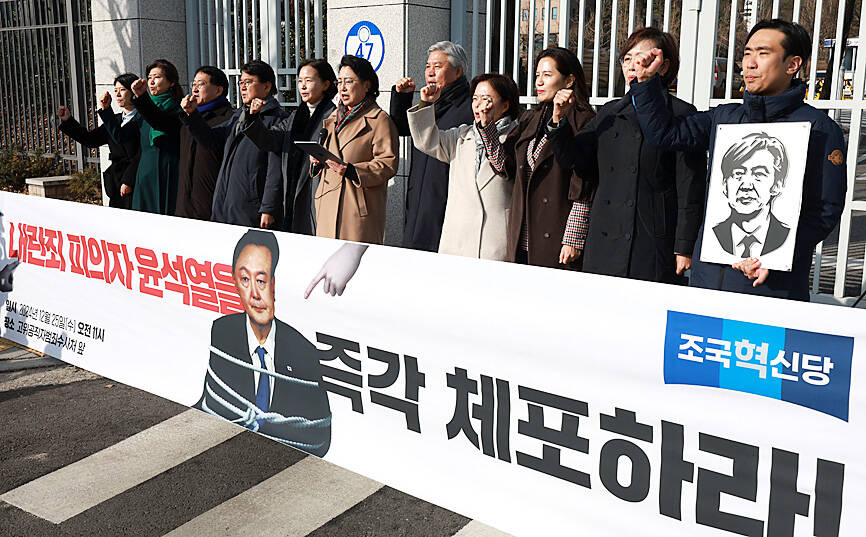South Korean President Yoon Suk-yeol yesterday did not respond to a second summons by anti-corruption authorities who, along with prosecutors, are investigating his short-lived martial law decree issued early this month.
Yoon had not appeared for questioning as of 10am as requested by the South Korean Corruption Investigation Office for High-ranking Officials, after ignoring its first summons last week.
An agency official said it would continue waiting for Yoon yesterday, adding that it would need to review the case further before seeking an arrest warrant, Yonhap news agency reported.

Photo: EPA-EFE
Yoon also did not respond on Dec. 15 to a separate summons by prosecutors who are investigating the martial law declaration, Yonhap said.
Yoon’s repeated defiance of the summons and failures to appear for questioning have sparked criticism and calls from the opposition for his arrest, citing concerns over potential destruction of evidence.
In a televised address on Dec. 7, four days after the martial law declaration, Yoon said he would not evade legal and political responsibility for his actions.
Yoon was impeached by parliament on Dec. 14 over his brief imposition of martial law and must now face a South Korean Constitutional Court trial on whether to remove him from office or restore his presidential powers.
Prosecutors, the police and the corruption investigation office have all launched probes into Yoon and other officials, seeking to pursue charges of insurrection, abuse of power or other crimes.
Insurrection is one of the few charges for which a South Korean president does not have immunity.
A lawyer advising Yoon has said he is willing to present his views in person during legal proceedings related to the martial law declaration.

‘UNUSUAL EVENT’: The Australian defense minister said that the Chinese navy task group was entitled to be where it was, but Australia would be watching it closely The Australian and New Zealand militaries were monitoring three Chinese warships moving unusually far south along Australia’s east coast on an unknown mission, officials said yesterday. The Australian government a week ago said that the warships had traveled through Southeast Asia and the Coral Sea, and were approaching northeast Australia. Australian Minister for Defence Richard Marles yesterday said that the Chinese ships — the Hengyang naval frigate, the Zunyi cruiser and the Weishanhu replenishment vessel — were “off the east coast of Australia.” Defense officials did not respond to a request for comment on a Financial Times report that the task group from

Asian perspectives of the US have shifted from a country once perceived as a force of “moral legitimacy” to something akin to “a landlord seeking rent,” Singaporean Minister for Defence Ng Eng Hen (黃永宏) said on the sidelines of an international security meeting. Ng said in a round-table discussion at the Munich Security Conference in Germany that assumptions undertaken in the years after the end of World War II have fundamentally changed. One example is that from the time of former US president John F. Kennedy’s inaugural address more than 60 years ago, the image of the US was of a country

DEFENSE UPHEAVAL: Trump was also to remove the first woman to lead a military service, as well as the judge advocates general for the army, navy and air force US President Donald Trump on Friday fired the chairman of the Joint Chiefs of Staff, Air Force General C.Q. Brown, and pushed out five other admirals and generals in an unprecedented shake-up of US military leadership. Trump wrote in a post on Truth Social that he would nominate former lieutenant general Dan “Razin” Caine to succeed Brown, breaking with tradition by pulling someone out of retirement for the first time to become the top military officer. The president would also replace the head of the US Navy, a position held by Admiral Lisa Franchetti, the first woman to lead a military service,

BLIND COST CUTTING: A DOGE push to lay off 2,000 energy department workers resulted in hundreds of staff at a nuclear security agency being fired — then ‘unfired’ US President Donald Trump’s administration has halted the firings of hundreds of federal employees who were tasked with working on the nation’s nuclear weapons programs, in an about-face that has left workers confused and experts cautioning that the Department of Government Efficiency’s (DOGE’s) blind cost cutting would put communities at risk. Three US officials who spoke to The Associated Press said up to 350 employees at the National Nuclear Security Administration (NNSA) were abruptly laid off late on Thursday, with some losing access to e-mail before they’d learned they were fired, only to try to enter their offices on Friday morning